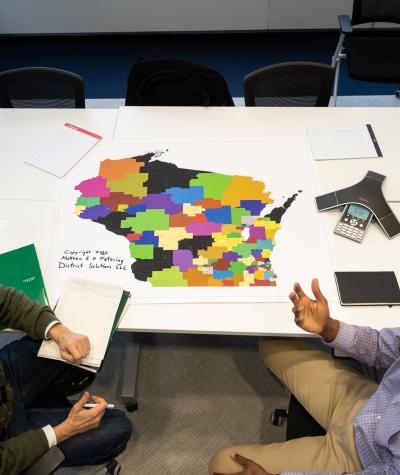In Wisconsin, voters were forced to decide whether they wanted to risk contracting or spreading the coronavirus to exercise their right to vote.
A contentious legal battle over the Wisconsin election quickly rose to the U.S. Supreme Court on April 6, 2020, which ultimately concluded that it would not extend the state’s absentee ballot deadline to April 13.
Many voters, without real options to vote by mail, had to show up to crowded in-person voting locations, and only five of the usual 180 polling locations were open in the state’s biggest city, Milwaukee, with similar closures occurring statewide.
The extreme gerrymander drawn in Wisconsin in 2011 is the reason Republicans hold nearly two-thirds of the seats in the State Assembly despite winning less than half of the votes statewide. As a result, Wisconsin citizens say that government has become less responsive to their concerns because of the gerrymander.
A properly functioning government body could have anticipated challenges related to voting during the coronavirus pandemic and come up with a bipartisan solution weeks earlier. However, inflated partisan majorities in the Assembly and Senate, along with polarization in the state government, played a role in making that difficult.
Gerrymandering can fuel increased polarization because when the only races that matter are partisan primaries, there are regrettably no incentives to build consensus across the political aisle – which makes problem-solving more difficult.
As Campaign Legal Center’s (CLC) Ruth Greenwood told The Guardian, the link between gerrymandering and Wisconsin’s election fiasco was undeniable. “It definitely all feeds on itself,” she said. “Gerrymandering has meant there are less competitive elections,” so politicians continue to put restrictions on the electorate to advantage themselves.
Greenwood and I were on the legal team that represented the Wisconsin voters who challenged the map, in CLC’s case, Gill v. Whitford, which made it to the U.S. Supreme Court.
It is no secret that the gerrymandered maps that Republicans drew in a secret room in a private law firm back in 2011 laid the foundation for a less accountable government with only partisan advantage in mind. Living this reality, Wisconsin voters, regardless of party affiliation, continue to support nonpartisan redistricting reform.
On April 7, 2020, all nine Wisconsin counties with Fair Maps advisory referenda on their ballots approved the measures with 70% support or above. Thirteen municipalities also approved Fair Maps referenda by large margins.
Citizens in other states are also taking the fight against gerrymandering into their own hands.
States Charge Forward with Fair Maps Reforms
Wisconsin’s neighbor, Illinois, is seeking to become the next in a wave of states that want to take back the power of redistricting from politicians.
Citizen-led independent redistricting commissions (IRCs) have taken on added urgency after the U.S. Supreme Court’s refusal in 2019 to stop even the most extreme partisan gerrymanders, shutting the federal courtroom door to legal challenges.
IRCs passed in states like Michigan contain added protections that redrawn district maps must not discriminate against any political party or individual.
Like Michigan, Colorado, Missouri, and the rest of the states adopting redistricting reform, Illinois needs to give citizens the opportunity to choose their own politicians, rather than the other way around, and ensure accountable representation. Advocates in the state have been working for years to change the way the state draws its electoral districts.
The current Illinois redistricting process is notoriously broken. Nothing stops the party in power at the time of redistricting from slicing and dicing voters into districts for partisan advantage. If neither party controls the state legislature, a “backup” commission is formed, with equal numbers of Democrats and Republicans.
This backup commission has only reached a compromise once, meaning that every other time the names of one Republican and one Democrat are put into a hat, and the party that is chosen gets complete control of drawing the state’s maps. This process does not lead to fair maps.
According to Andy Shaw with CHANGE Illinois Action Fund, in 2018 nearly half of the state legislative races in Illinois had only one candidate. If you factor in races with landslide victories, nearly 80% were uncompetitive.
The structure of IRCs vary from state to state, but IRCs are a valuable citizen tool designed to make the redistricting process more transparent and impartial by establishing standards for who can serve on the commission and criteria to improve fairness when drawing district maps.
The proposed IRC in Illinois would create a 17-member independent commission to draw districts that are fully compliant with the Voting Rights Act and other federal laws. The districts would need to be contiguous and compact and would provide limits on partisan gerrymandering.
Prior to the Illinois measure going before voters, the general assembly has a May 3 deadline to vote on the Fair Maps amendment, which would move the state towards an IRC.
CLC is part of a diverse coalition of national and state organizations led by CHANGE Illinois advocating for the Fair Maps amendment, which was introduced with bipartisan support.
Redistricting is scheduled to take place in Illinois shortly after the 2020 Census concludes. That means that this spring is the last chance Illinois has to get its redistricting process right before potentially being stuck with gerrymandered maps again for the next decade.
The people of Illinois overwhelmingly support redistricting reform. An independent poll by the Southern Illinois University’s Paul Simon Institute found that 67% of Illinois voters want an IRC to draw the legislative lines.
Illinois voters are tired of waiting for politicians to give up their redistricting power and expect the legislature to take action on May 3.

